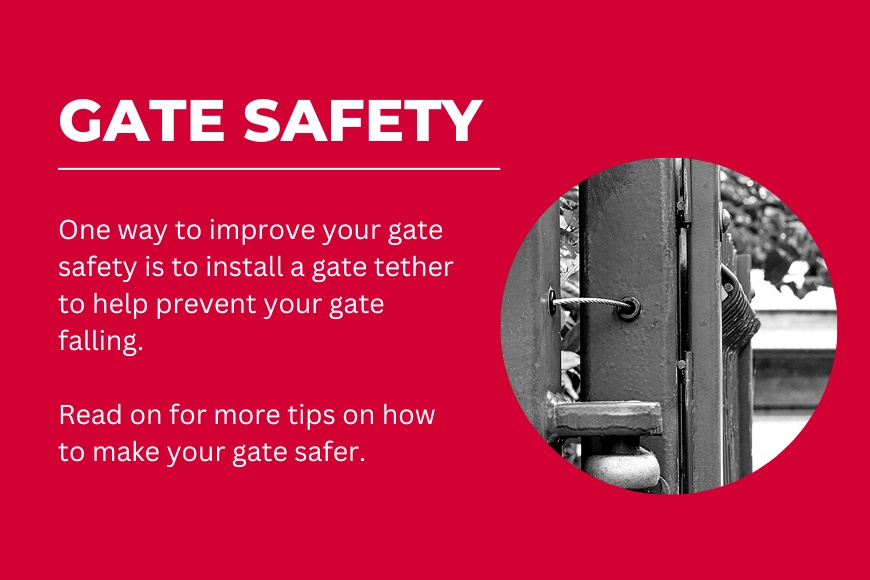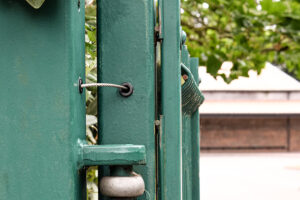Autumn is well and truly upon us and with the changing colours comes stronger winds, more rain, and the occasional storm. In addition to incentivising indoor days, ‘sweater weather’ can lead to disasters when it comes to gates.
Almost every year, there are stories of gates falling in bad weather. Whether this is caused by rusty hardware or weakened posts, the risks are high. In this article, we discuss the falling risk of swing gates and how to help mitigate it.
Gates keep on falling
There has been a lot of focus on gate safety due to several tragedies involving falling gates. Without getting into too much detail, such an event can lead to serious personal injury. For fencing installers, manufacturers, and fabricators, not only is such an event devastating, but it can be expensive for the installer if the gate is found unsafe.
The incentives to ensure a strong, and safe gate from the beginning are high. There are several factors that can make a gate safer, and the responsibility lies with in many different hands as the project progresses.
How to improve gate safety
Choose the right hardware for safer gates
An important part of ensuring safe gates is naturally the installation of the gate. But the road to safe gates starts way before the gate is actually installed.
Before this, you need to source the correct hardware and make sure it is suitable for the gate at hand. That includes:
- Checking if the hinges can safely carry the weight of the gate
- Ensuring the hinges can be installed in a way to avoid a single load bearing hinge
- Analysing the risks in the area and use drop bolts, gate stops and other gate accessories to ensure a gate without trapping hazards
- Look into products that can assist should a hinge fail like using a gate tether
The risks associated with the gate will vary with each project.
Getting the hardware right is the first step. Next comes the installation.
How can fencing installers help install safer gates?
For the fencing installers, you usually have to install it with what you are given. But a good fencing installer will review the risks on site as well and report back if any risks are found.
The organisation Gate Safe advised on the different risks associated with manual gates in the following article.
The importance of maintenance
But the work doesn’t stop once the gate has been installed.
A major cause of failing (and falling) gates is lack of maintenance. Even if advised, your customers might forget all about the gate at the end of the garden in their annual garden clear up. And so, the gate is forgotten and left to rust away. Until one day, when the hinge breaks and it falls down into the back alley, leaving not only the garden defenceless but could have caused damage or serious injuries in the process.
So, maintenance is key. This includes checking the below:
- Does the gate run smoothly?
- Are the hinges in good condition?
- Has the environment changed that could affect the gate?
- Shifting soil due to flooding or rain?
- Sunken gate posts?
- Loose fixings due to slamming the gate one too many times?
Telling your customers to do annual maintenance of their gates is a step in the right direction. They might not do it in the long-term, but at least you have advised them properly and given them the necessary information to take proper care of their gates.
Other precautions you can take
If you are already doing the above things, that is great! But there are more precautions you can take or recommend to your customers.
One of them is installing a gate tether on the gate.
A gate tether is a device that helps ensure the gate doesn’t come crashing down if one of the hinges breaks. The GRS from Gatemaster is installed inconspicuously in the gate frame of the gate post and the gate. It acts like a lifeline and will prevent the gate from falling down. This gate tether uses a 3mm or 4mm braided stainless steel wire, which keeps the gate in place.
Another recommendation is to install three hinges on the gate, but this should ideally be combined with a gate tether. Many installers prefer to use two hinges and a gate tether to avoid binding when using three hinges.
A sleek and practically invisible gate tether could be the extra gate safety precaution you need for your gates.




